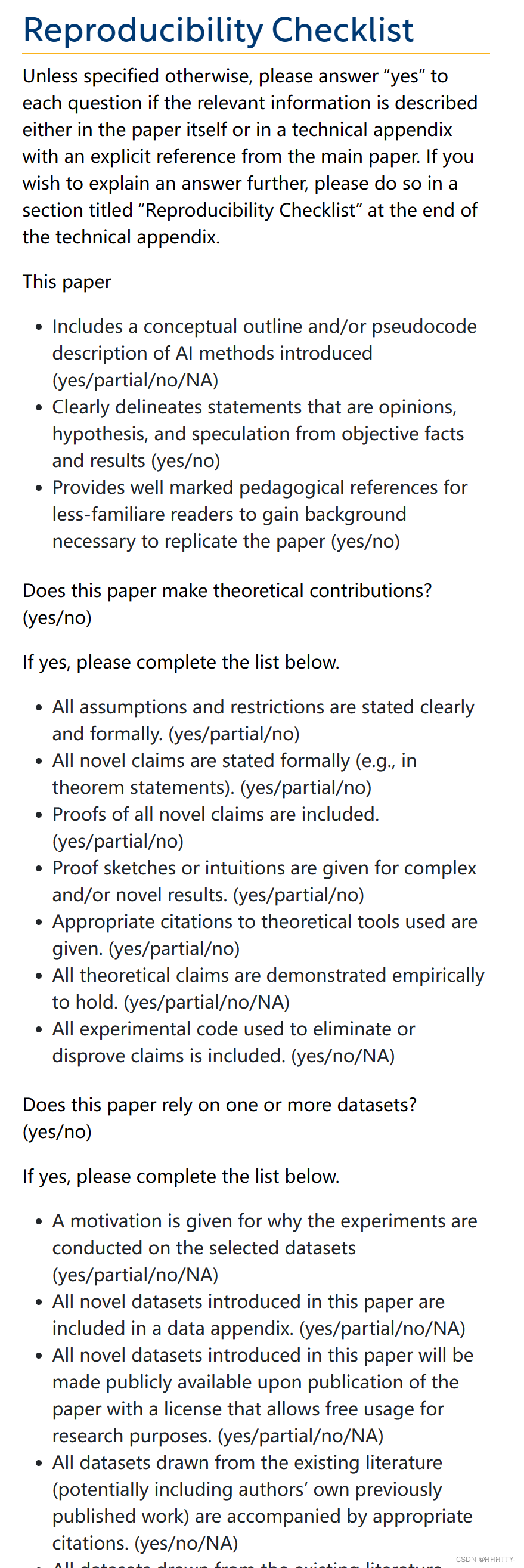Table of contents
-
- AAI 2024
- Past Conferences
- AAI 2024
- Timetable
- Main Technical Track
- AAAI-2023
- Where is the AAAi2022 paper template?
- 2023 example
- AAAI-24 Submission Instructions
- **Reproducibility Guidelines**
- AAAI-2020 post notice
- AAAI 2022 Top Conference Submission Instructions! Attached important time nodes
- Questions and Suggestions Questions and Suggestions
- Supplementary Material
AAI 2024
- submit:
https://cmt3.research.microsoft.com/AAAI2024
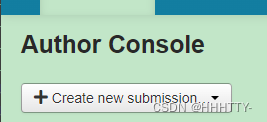
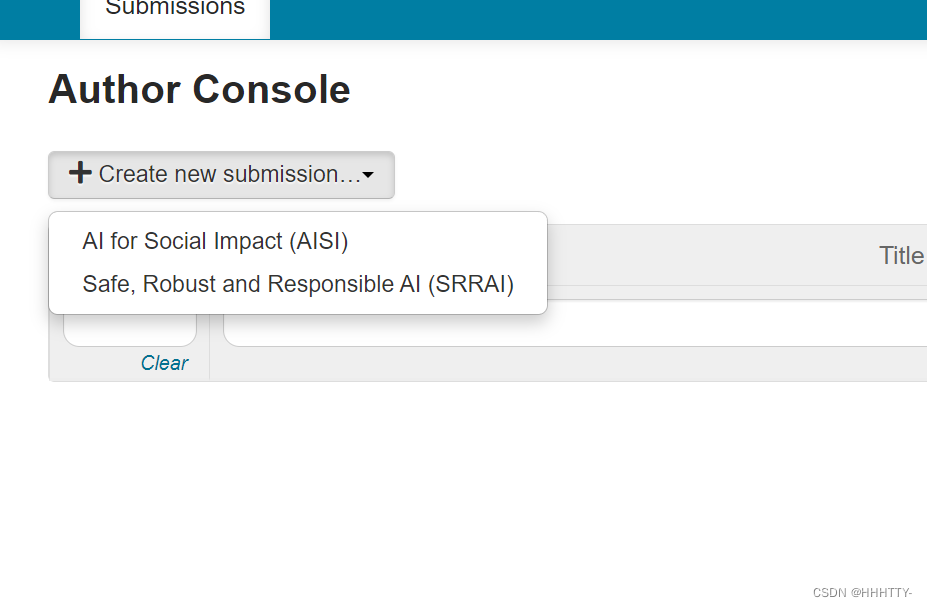
Past Conferences
For information about past AAAI Conferences, please consult the following pages.
- https://aaai.org/conference/aaai/

AAI 2024
-
https://aaai.org/aaai-conference/
-
https://aaai.org/aaai-conference/aaai-24-call-for-proposals
38th Annual AAAI Conference on Artificial Intelligence, Vancouver, Canada, February 2024
- The Thirty-Eighth Conference on Artificial Intelligence will be held in Vancouver, British Columbia, Canada from February 20-27, 2024.
The 38th Annual AAAI Conference on Artificial Intelligence
Detailed Instructions
- https://aaai.org/aaai-conference/aaai-24-call-for-proposals/#conference-timetable
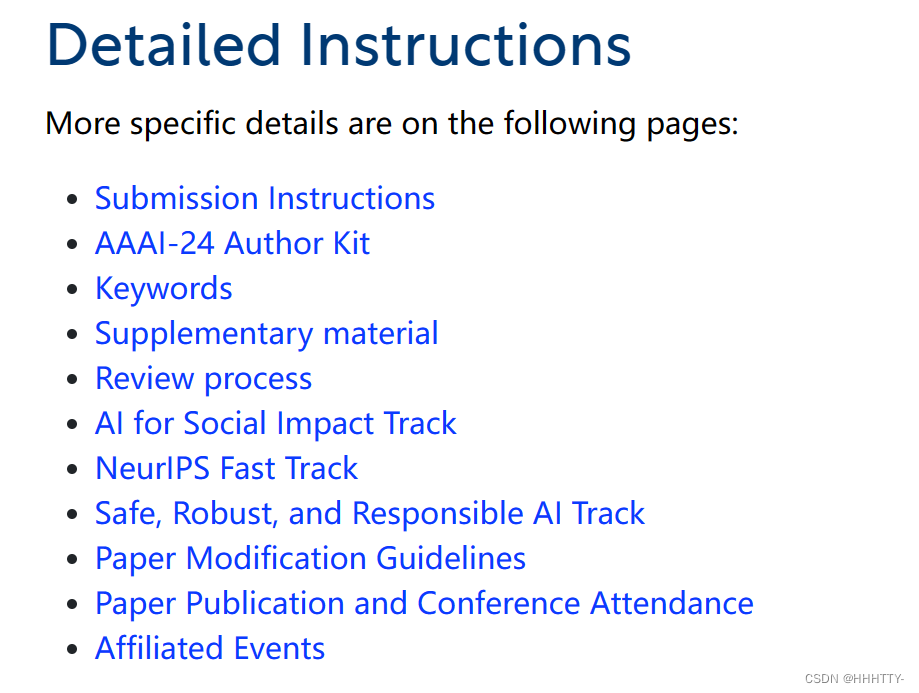
AAAI2024 template
1、 https://aaai.org/aaai-conference/aaai-24-call-for-proposals/
2、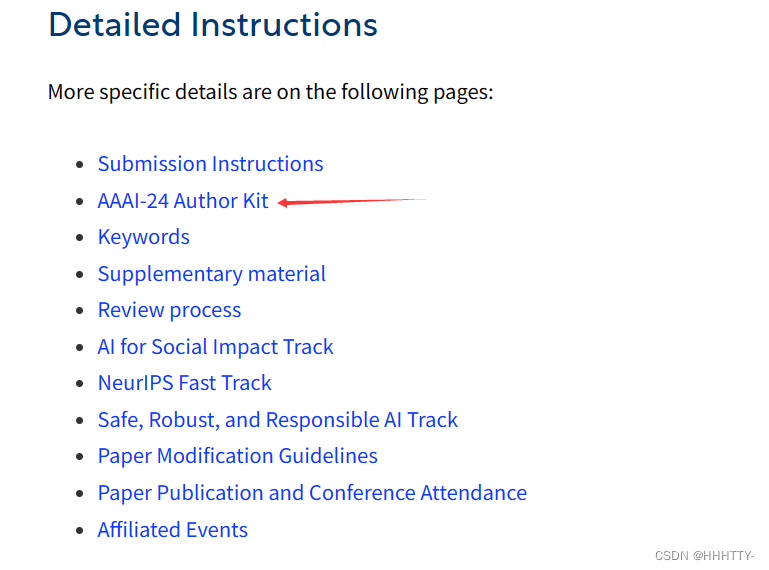
Timetable
- Main Conference Timetable for Authors
Note: all deadlines are “anywhere on earth” (UTC-12)
July 4, 2023
AAAI-24 web site open for author registration
July 11, 2023
AAAI-24 web site open for paper submission
August 8, 2023
Abstracts dueat 11:59 PM UTC-12
August 15, 2023
Full papers dueat 11:59 PM UTC-12
August 18, 2023
Supplementary material and code due by 11:59 PM UTC-12
September 25, 2023
Registration, abstracts and full papers for NeurIPS fast track submissions due by 11:59 PM UTC-12
September 27, 2023
Notification of Phase 1 rejections
September 28, 2023
Supplementary material and code for NeurIPS fast track submissions due by 11:59 PM UTC-12
November 2-5, 2023
Author feedback window
December 9, 2023
Notification of final acceptance or rejection
December 19, 2023
Submission of paper preprints for inclusion in electronic conference materials
February 20 – February 27, 2024
AAAI-24 conference
Thank you very much for providing the detailed schedule for the 38th Annual AAAI Conference on Artificial Intelligence, which will be held in Vancouver, Canada, February 20-27, 2024: NOTE: All deadlines are "Anywhere on
Earth " (UTC-12)
July 4, 2023
AAAI-24 website opens for author registration
July 11, 2023
AAAI-24 website opens for paper submissions
August 8, 2023
Abstract submission deadline is 11:59 pm (UTC-12)
August 15, 2023
The deadline for submission of the full text is 11:59 pm (UTC-12)
August 18, 2023
Supplementary material and code submission deadline is 11:59 pm (UTC-12)
September 25, 2023
NeurIPS Fast Track submission deadline for registration, abstract and full text submissions is 11:59 PM (UTC-12)
September 27, 2023
Phase 1 Rejection Notice
September 28, 2023
The deadline for supplementary materials and code submissions for NeurIPS fast track submissions is 11:59 pm (UTC-12)
November 2-5, 2023
Author Feedback Time Window
December 9, 2023
Notification of final acceptance or rejection
December 19, 2023
Submit paper preprints for inclusion in electronic conference materials
AAAI-24 Meeting February 20-27, 2024
Main Technical Track
- https://aaai.org/aaai-conference/aaai-24-call-for-proposals/#conference-timetable
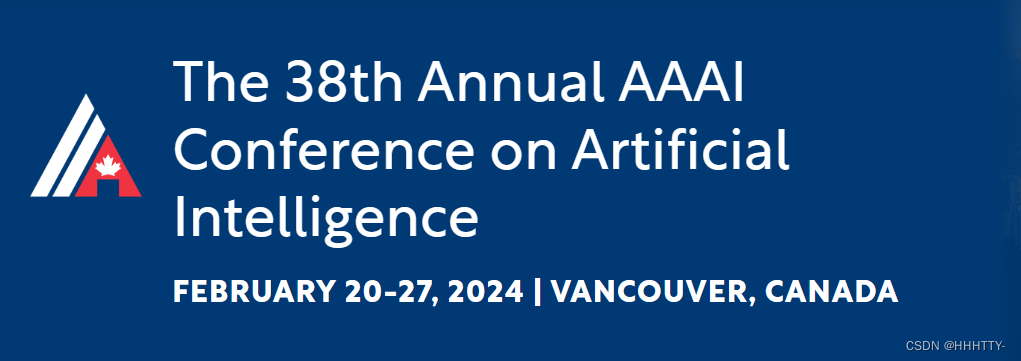
Summary
- Three technical tracks (Main Track; AI for Social Impact; Safe, Robust and Responsible AI)
- Two-phase reviewing: two reviews in Phase 1, additional reviews in Phase 2 for papers not rejected in Phase 1. Author response after Phase 2, only for papers not rejected in Phase 1.
- Three kinds of supplementary material may be submitted alongside all papers: (1) technical appendix; (2) multimedia; (3) code and data. Supplementary material deadline is 3 days after the paper submission deadline.
- Additional pages for references only.
- All authors must complete a reproducibility checklist, which facilitates replication of the reported research.
- All authors are expected to be available to review (light load), unless extenuating circumstances apply.
- NeurIPS-23 Fast Track: rejected papers with final, average scores of at least 4.9 may be submitted directly into AAAI-24’s Phase 2 along with, previous reviews and paper ID.
- Three technical themes (main track; AI for social impact; safe, robust and responsible AI)
- Two-stage review: the first stage has two reviews ,
- The second stage is an additional review for papers that were not rejected in the first stage .
- Author responses after the second stage, only for papers that were not rejected in the first stage.
- All papers can submit three types of supplementary materials: (1) technical appendices; (2) multimedia; (3) code and data.
- The deadline for supplementary materials is 3 days after the paper submission deadline .
- Additional reference pages.
- All authors must complete a replicability checklist in order to reproduce the reported study.
- Unless there are special circumstances, all authors should provide a review (light load).
- NeurIPS-23 Fast Track: Rejected papers can be submitted directly to Phase 2 of AAAI-24 , with previous reviewers and paper ID attached, as long as they have a final, average score of at least 4.9.
The purpose of the AAAI conference series is to promote research in Artificial Intelligence (AI) and foster scientific exchange between researchers, practitioners, scientists, students, and engineers across the entirety of AI and its affiliated disciplines. AAAI-24 is the Thirty-Eighth AAAI Conference on Artificial Intelligence. As with AAAI-23, the theme of this conference is to create collaborative bridges within and beyond AI. In addition to the bridge theme, we emphasize the importance of AI for social impact and responsible AI. Like AAAI 2023 conference, AAAI-24 will feature technical paper presentations, special tracks, invited speakers, workshops, tutorials, poster sessions, senior member presentations, competitions, and exhibition programs, and two other activities: a Bridge Program and a Lab Program. Many of these activities are tailored to the theme of bridges and are selected according to the highest standards, with additional programs for students and young researchers.
We plan for AAAI-24 to be an in-person conference. Given the volatile situation, however, the exact format of the conference can only be decided at a later stage.
The purpose of the AAAI Conference Series is to advance the study of artificial intelligence (AI) and to facilitate scientific communication among researchers, practitioners, scientists, students, and engineers, covering all aspects of AI and its related disciplines.
AAAI-24 is the 38th AAAI Conference on Artificial Intelligence. Like AAAI-23, the theme of this conference is to create bridges of collaboration inside and outside of AI. In addition to the theme, we also emphasize the importance of AI's impact on society and responsible AI.
Like the AAAI 2023 conference, AAAI-24 will include technical paper presentations, special topics, invited speakers, workshops, tutorials, poster sessions, senior member presentations, competitions and showcase programs, and two other events: bridge projects and labs project. Many of these activities are bespoke to the highest standards, dovetailing with the bridge theme and providing additional programs for students and young researchers.
We planned the AAAI-24 meeting as an offline meeting. However, given the uncertainty of the situation, the exact format of the meeting can only be decided at a later stage.
Topics
AAAI-24 welcomes submissions reporting research that advances artificial intelligence, broadly conceived. The conference scope includes machine learning, natural language processing, computer vision, data mining, multiagent systems, knowledge representation, human-in-the-loop AI, search, planning, reasoning, robotics and perception, and ethics. In addition to fundamental work focused on any one of these areas, we expressly encourage work that cuts across technical areas of AI (e.g., machine learning and computer vision; computer vision and natural language processing; or machine learning and planning), bridges between AI and a related research area (e.g., neuroscience; cognitive science), or develops AI techniques in the context of important application domains, such as healthcare, sustainability, transportation, and commerce.
The set of AAAI-24 keywords is available on the AAAI-24 keywords page. The author’s guide for choosing the best keywords describes important considerations in selecting keywords for a paper.
Most papers in AAAI-24 will be part of the main track. All main track papers will be reviewed according to the same criteria and via the same process. This conference has two special tracks, which focus on AI for Social Impact, and Safe, Robust, and Responsible AI. Papers in the special tracks will be reviewed according to a different evaluation rubric than papers in the main track. The same reviewing schedule will be followed for all papers.
theme
- AAAI-24 welcomes submissions that demonstrate research advances in artificial intelligence, broadly speaking.
- Conference areas include machine learning, natural language processing, computer vision, data mining, multi-agent systems, knowledge representation, AI for human-computer interaction, search, planning, reasoning, robotics and perception, and ethics.
In addition to focusing on fundamental work in these areas, we specifically encourage work in technical areas that span AI (for example, machine learning and computer vision; computer vision and natural language processing; or machine learning and planning), between AI and related research areas. Building bridges between AI (e.g., neuroscience; cognitive science), or developing AI technologies in important application areas such as healthcare, sustainability, transportation, and business.
The AAAI-24 keyword set can be found on the AAAI-24 keywords page.
- An Author's Guide to Choosing the Best Keywords describes important considerations for choosing keywords for your paper.
Most of the papers at AAAI-24 will be part of the main track. All main track papers will be reviewed against the same criteria and go through the same process.
The conference has two special tracks focusing on AI for social impact and AI that is safe, robust and responsible. Papers on special topics will be reviewed according to different assessment criteria than main track papers. All papers will follow the same review schedule.
AAAI-2023
This text contains detailed guidelines for submitting papers to the **Thirty-eighth AAAI Conference on Artificial Intelligence (AAAI-23)**. Here are the main points:
- Author Registration: Authors must register with AAAI-23's online technical paper submission site before submitting papers and abstracts. Authors must use the same CMT account (ie, an account associated with the same email address) for all submission and review tasks .
2. Abstract and paper submission: An abstract and corresponding paper are required for each submission. For general papers, abstracts must be submitted by August 8, 2022, and full papers must be submitted by August 15, 2022. For Fast Track papers, both abstracts and full papers must be submitted by September 16, 2022.
3. Paper format: Papers must be formatted in accordance with the AAAI two-column style suitable for publication. Submitted papers should be in glitch-free, high-resolution PDF format.
4. Double-blind review: AAAI submissions are anonymous and must follow the instructions for double-blind review.
-
Limit on the number of papers submitted per author: Each author can submit up to 10 papers to the AAAI-23 technical paper track (including papers on the social impact of AI and security and robust AI tracks), and after submission, the author can no longer be added to the paper.
-
Multiple submission policy with conferences or journals: AAAI-23 will not consider papers that are under review or have already been published or accepted for publication in any archival venue such as a journal or conference at the time of submission.
-
Citations and comparisons: Papers should cite the vetted publications most relevant to their content.
-
Reproducibility Guidelines: When submitting a paper, authors must complete a reproducibility checklist, which outlines how to reproduce the results of the submission.
-
Ethics Policy: All AAAI authors and reviewers are required to abide by the AAAI Statement of Publication Ethics and Misconduct, and the AAAI Code of Professional Conduct.
-
Demonstration: When submitting a paper, authors will be able to express interest in a public demonstration of the system described in the paper. Based on these expressions of interest and reviews, papers will be selected for presentation sessions, which will take place in addition to technical talks and posters.
Where is the AAAi2022 paper template?
https://www.zhihu.com/question/472604605/answer/2015631434
2023 example
Official website: https://aaai-23.aaai.org/

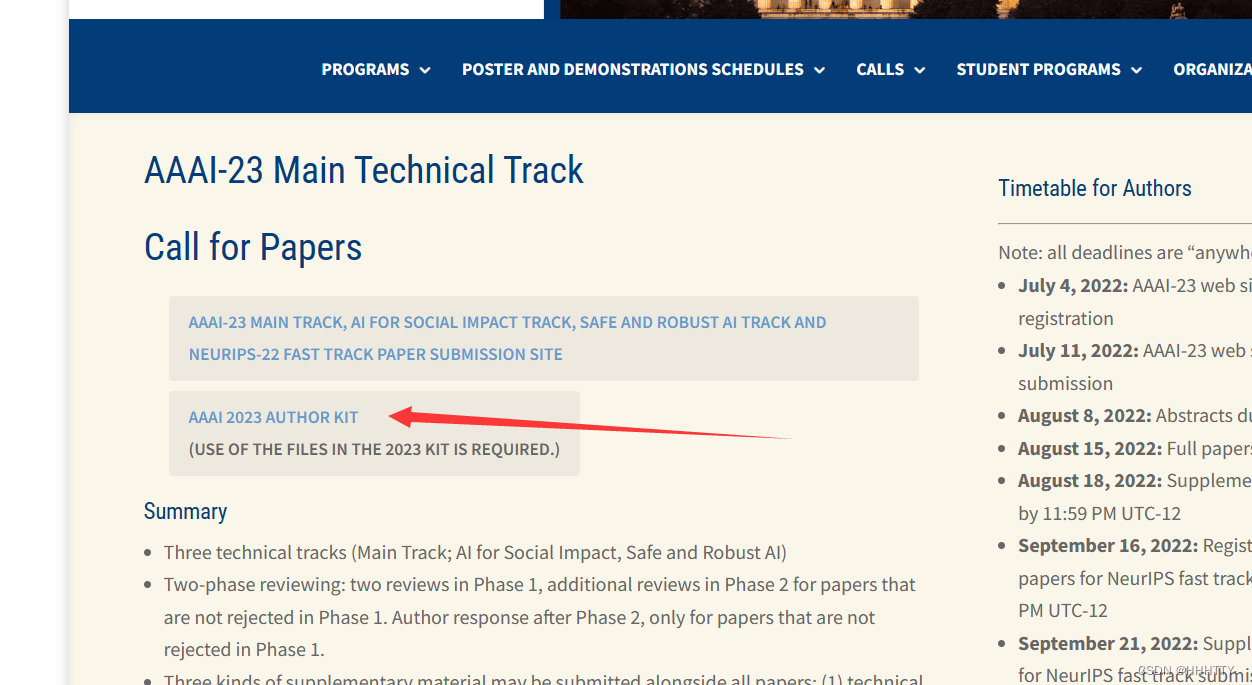
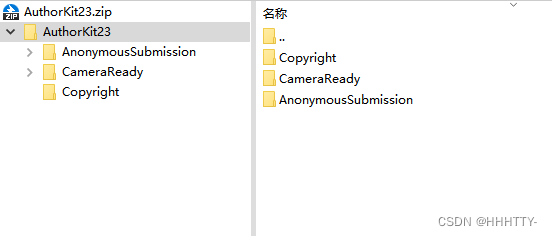
AAAI-24 Submission Instructions
1、Author Registration
Authors must register at the AAAI-24 web-based technical track paper submission site before they can submit abstracts and papers. To avoid last-minute congestion, authors are encouraged to register well in advance of the abstract deadline. Authors are required to use the same CMT account (i.e., associated with the same email address) across all submissions and review assignments.
IMPORTANT: Authors must enter the names of ALL AUTHORS at the time of registration (by abstract deadline) — CMT includes a hard-coded note that this is optional, however, this is a mandatory step for AAAI-24 authors. According to AAAI policy, all author names must be added at the time of abstract registration, and the list of names as well as the order in which they appear cannot be changed after August 15. In addition, the contact author and contact information cannot be changed after the abstract submission deadline. For the complete policy on Guidelines for Changes to Titles/Authors after Submissions, please see below.
Given the size of the conference, all authors of AAAI-24 submissions will be expected to join the conference’s reviewer pool unless prevented by extenuating circumstances. Potential reviewers will be vetted based on their research experience, and depending on this experience may be selected as program committee or senior program committee members.
Authors must register with the AAAI-24 web-based technical monograph submission site prior to submitting abstracts and papers.
- To avoid last-minute congestion, authors are advised to complete registration in advance.
- Authors need to use the same CMT account (ie, associated with the same email address) for all paper submissions and review assignments .
IMPORTANT NOTE: At registration (i.e. by the abstract deadline) authors must enter all author names - although CMT notes that this step is optional, it is mandatory for AAAI-24 authors .
- According to AAAI policy, all author names must be added at the time of abstract submission, and once the list and author order cannot be modified after August 15th .
- Also, contact authors and contact information cannot be changed after the abstract submission deadline . See below for a detailed policy on modifying title/author after submission.
Given the size of the conference, it is expected that all submitters to AAAI-24 will join the conference's review team , unless exceptional circumstances prevent it.
- Potential reviewers will be vetted based on their research experience, on the basis of which they may be selected for program committee membership or senior program committee membership.
2、Abstract and Paper Submission
very submission requires both an abstract submission and a corresponding paper submission. For regular papers, abstracts must be submitted by August 8, 2023 and full papers must be submitted by August 15, 2023. For fast track papers, both abstracts and full papers must be submitted by September 25, 2023. There will be no individual exceptions. If you experience any technical problems with the CMT site, please contact the AAAI-24 Workflow Chairs at [email protected].
Submissions will not be accepted by e-mail or any other mechanism other than CMT. After submission, the system will not automatically send a confirmation of receipt. If you want to receive a confirmation email, please click the paper ID to view the submission, and then click the “Email” button at the top right to send the confirmation to yourself or all the authors. AAAI will contact authors again only if problems are encountered with papers. We intend to close the submission system exactly at the deadline. Once the deadline has passed, we regret that we will be unable to make individual exceptions or to correspond with authors regarding circumstances that prevented timely submission.
At the time of abstract submission, authors should include a full title for their paper and a complete abstract in the fields provided. Submissions that have “placeholder” (e.g., test or xyz) titles or abstracts (or none at all) will be deleted. Authors of such vacuous submissions will be notified that their abstract has been deleted and will not be allowed to submit a full paper. The Program Chairs also reserve the right to reject papers without review if they change their abstracts substantially between the abstract and final deadlines.
Papers must be formatted in AAAI two-column, camera-ready style; see the AAAI-24 author kit for details. Papers must be in trouble-free, high-resolution PDF format, formatted for US Letter (8.5″ x 11″) paper, using Type 1 or TrueType fonts. AAAI submissions are anonymous and must conform to the instructions (detailed below) for double-blind review. The authors must remove all author and affiliation information from their submission for review, and may replace it with other information, such as paper number and keywords. Submissions may consist of up to 7 pages of technical content plus additional pages solely for references; acknowledgements should be omitted from papers submitted for review.
Only PDF files are required at the time of submission for review; authors will additionally need to submit paper source files if their paper is accepted for publication.
Each paper submission requires an abstract and a corresponding paper.
- For regular papers, abstracts must be submitted by August 8, 2023, and full papers must be submitted by August 15, 2023 .
- For fast-track papers, both abstracts and full papers must be submitted by September 25, 2023. There will be no individual exceptions.
- If you experience any technical issues using the CMT website, please contact the AAAI-24 Workflow Chairs at [email protected].
Paper submissions will not be accepted via email or any other means other than CMT.
- Once submitted, the system does not automatically send a receipt confirmation. If you would like to receive a confirmation email, please click on the paper ID to view the submission, then click the "Email" button in the upper right corner to send a confirmation email to yourself or to all authors .
- AAAI will only contact the author again if there is a problem with the paper.
- We intend to close the submission system by the deadline. Once the deadline has passed, we will not be able to make exceptions for individual cases, or discuss with authors circumstances that prevent timely submission.
When submitting abstracts, authors should include a full title and full abstract for the paper in the fields provided.
- Submissions with titles or abstracts that are "placeholders" (eg, test or xyz) or not at all will be removed.
- Authors of such empty submissions will be notified that their abstracts have been removed and will not be allowed to submit full papers.
- Program chairs also reserve the right to refuse to review papers if they change the abstract substantially between the abstract and the final deadline.
Papers must be formatted in AAAI two-column, camera-ready style; see AAAI-24 Author Toolkit for details.
- Papers must be in glitch-free, high-resolution PDF format on US Letter (8.5" x 11"), using Type 1 or TrueType fonts. Submissions to AAAI are anonymous and must comply with the instructions for double-blind review (see below for details).
- Authors must remove all author and institutional information from their review submissions and may substitute other information, such as paper numbers and keywords.
- Submissions may include up to 7 pages of technical content , with additional pages for information only ;
- Acknowledgments should be removed from papers submitted for review. Authors are also required to submit the source files of the paper only when the paper is accepted for publication.
Submission Limit per Author
Each individual author is limited to no more than a combined limit of 10 submissions to the AAAI-24 technical track (including papers in the AI for Social Impact and Safe and Robust AI tracks) and authors may not be added to papers following submission (see below for policies about author changes).
Each individual author's total number of submissions to technical topics at AAAI-24 (including AI for Social Impact and Safe and Robust AI topics) must not exceed 10, and authors may not be added to a paper after submission (policy on author changes, see below).
Guidelines for Changes to Titles/Authors after Submissions
MODIFICATIONS TO SUBMISSIONS ARE ONLY ALLOWED UNTIL THE FULL PAPER DEADLINE (August 15 for Phase 1 submissions, September 25 for fast track submissions). No exceptions will be granted. Please see the full policy on Paper Modification Guidelines.
Amendments to submissions are only allowed before the full-text submission deadline (August 15 for Phase 1 submissions and September 25 for Fast Track submissions).
There will be no exceptions. Please review the full policy on guidelines for revision of papers.
Policy Concerning Multiple Submissions to Conferences or Journals
Policy AAAI-24 regarding submission of multiple papers to conferences or journals
will not consider any papers that are under review at the time of submission, or already in any archiving venue (such as journals or conferences, workshops and preprint servers such as arXiv are acceptable ) Papers published or accepted for publication.
- Authors may withdraw submissions from venues with concurrent review processes (e.g., from NeurIPS-23) and submit the same work to AAAI-24 as a regular paper, as long as this withdrawal occurs prior to the submission at AAAI-24.
- Authors must confirm upon submission that the paper is not under review at another archived conference or journal.
Citation and Comparison
Papers are expected to cite those refereed publications most relevant to their content, but authors are excused for not knowing about all non-refereed work (e.g, appearing on arXiv). Nevertheless, in cases where such prior work is widely known in the field, its existence may be considered by reviewers in assessing a submission’s novelty. Papers published less than two months before the regular paper submission deadline (August 15, 2023) are considered contemporaneous to all AAAI-24 submissions (whether submitted as regular or fast track submissions); authors are not obliged to address such papers (though, especially for the camera ready versions of accepted papers, authors are encouraged to do so).
Papers should cite the vetted publications that are most relevant to their content, but authors can be blind to all unreviewed work (eg, that appears on arXiv) .
- However, where such prior work is well known in the field, reviewers may consider the existence of such prior work in assessing the novelty of the submission.
- Papers published within two months of the regular paper submission deadline (August 15, 2023) will be considered contemporaneous with all AAAI-24 submissions (whether as regular or fast-track submissions); authors are not required to process such Papers (although, especially for final versions of accepted papers, authors are encouraged to do so).
Reproducibility Guidelines
Authors must complete a reproducibility checklist at the time of paper submission, which outlines how to reproduce the results of the submission. These responses will become part of each paper submission and will be shared with reviewers. Information related to reproducing experimental results described in the submission may be included in the main paper or the Code and Data Appendix, as appropriate. Further technical details (proofs, descriptions of assumptions, algorithm pseudocode) may be included in the Technical Appendix. When appropriate, authors are encouraged to include detailed information about each reproducibility criterion as part of their Technical Appendix. Reviewers will be asked to assess the degree to which the results reported in a paper are reproducible, and this assessment will be weighed when making final decisions about each paper.
Repeatability Guide
- Authors must complete a reproducibility checklist when submitting a paper , which outlines how to reproduce the results of the submission .
These responses will become part of every paper submission and will be shared with reviewers.- Information relevant to reproducing the experimental results described in the submission may be included in the main paper or in the code and data appendices , as appropriate.
Further technical details (proofs, description of assumptions, algorithm pseudocode) can be included in a technical appendix .- Where appropriate, authors are encouraged to include detailed information on each reproducibility criterion in their technical appendices .
Reviewers will be asked to assess the extent to which the results reported in the paper are reproducible and will weigh this assessment when making a final decision about each paper.
Reproducibility Checklist
- https://aaai.org/aaai-conference/reproducibility-checklist/
AAAI-2020 post notice
https://zhuanlan.zhihu.com/p/81930463
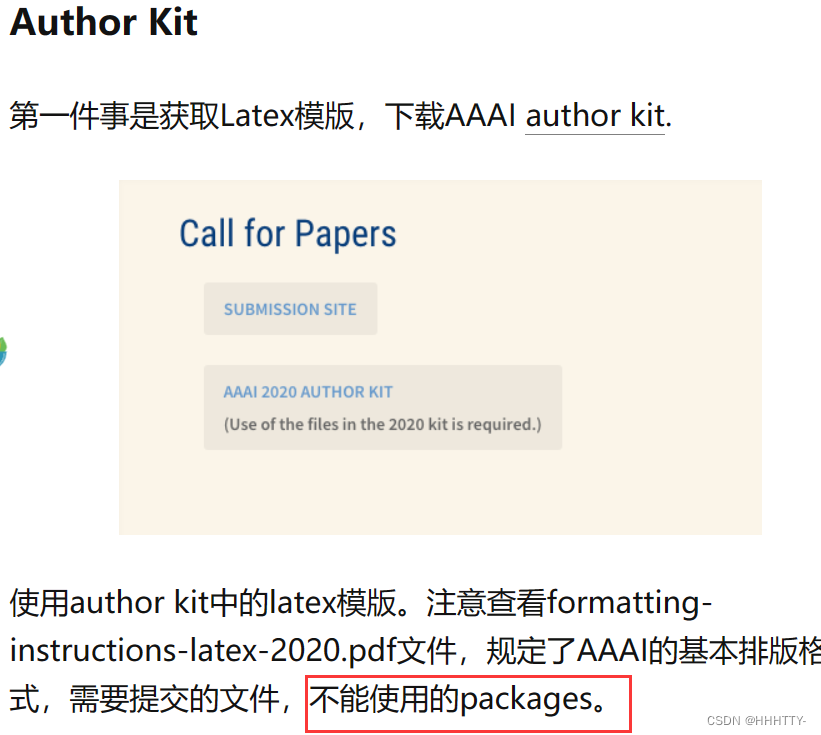
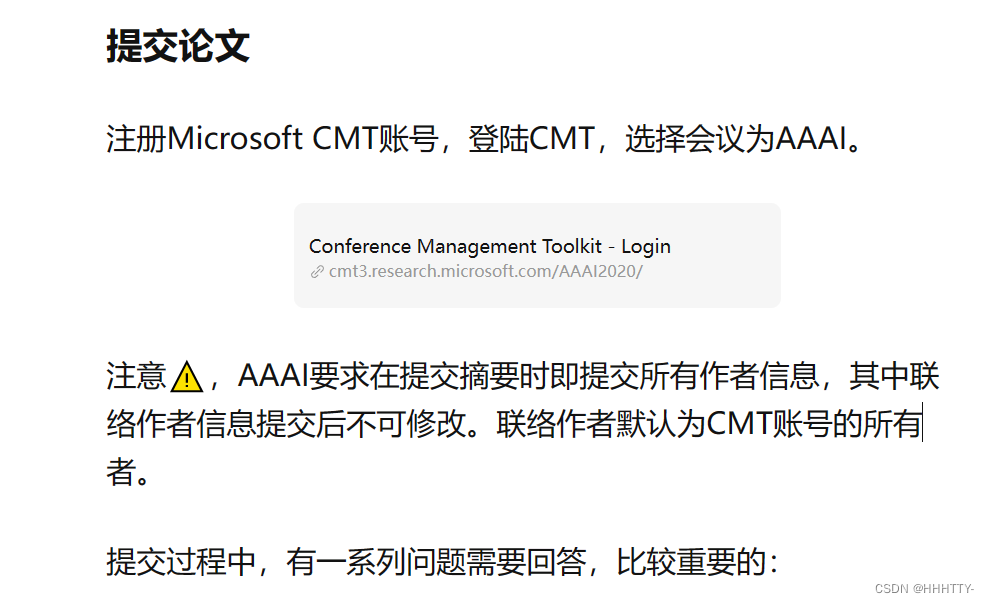

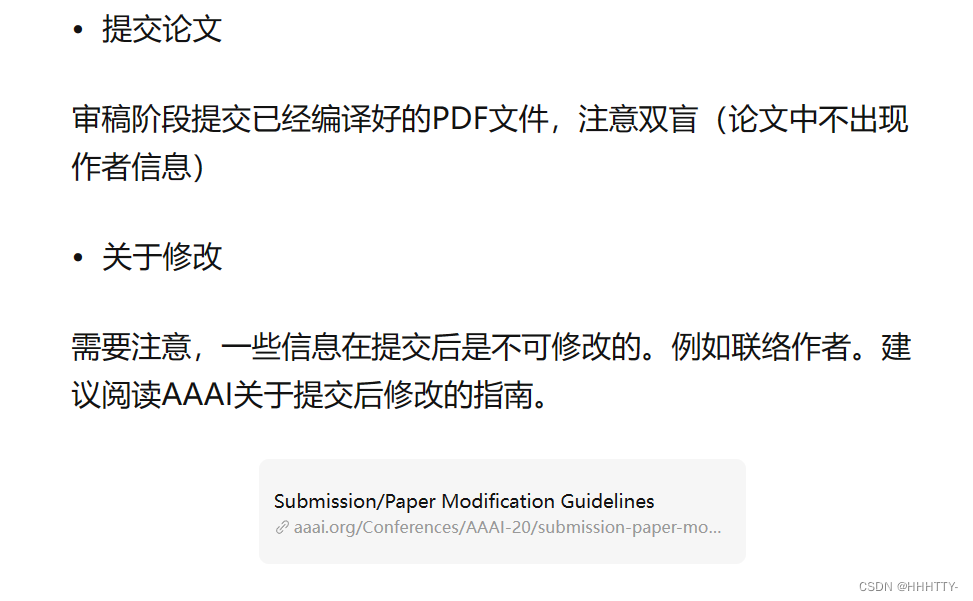
AAAI 2022 Top Conference Submission Instructions! Attached important time nodes
https://zhuanlan.zhihu.com/p/398397348

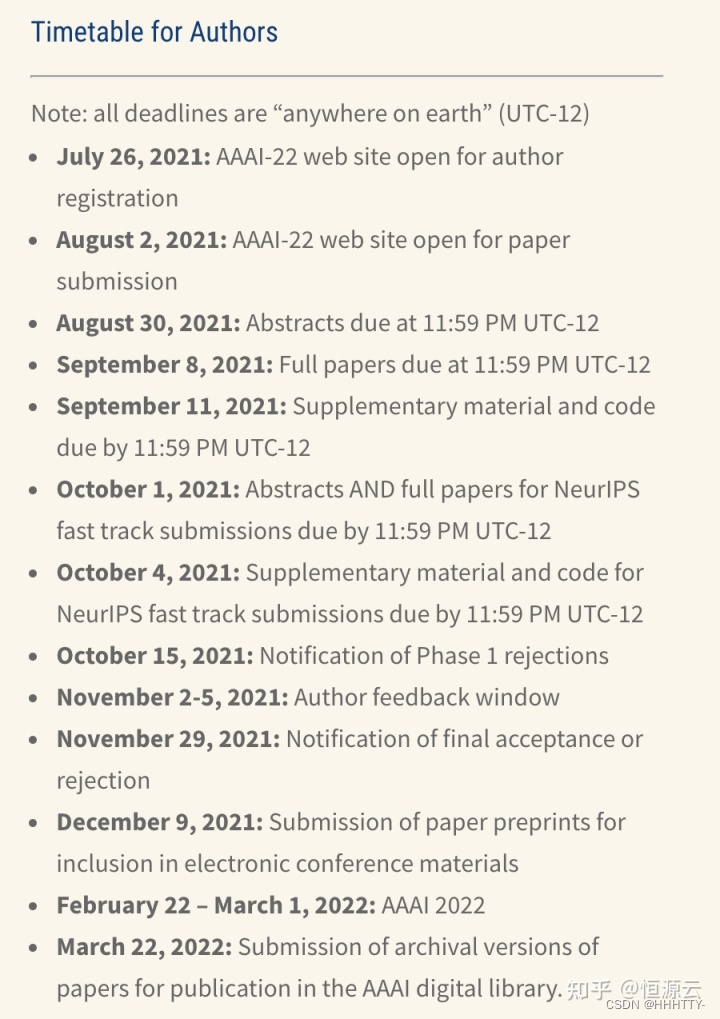
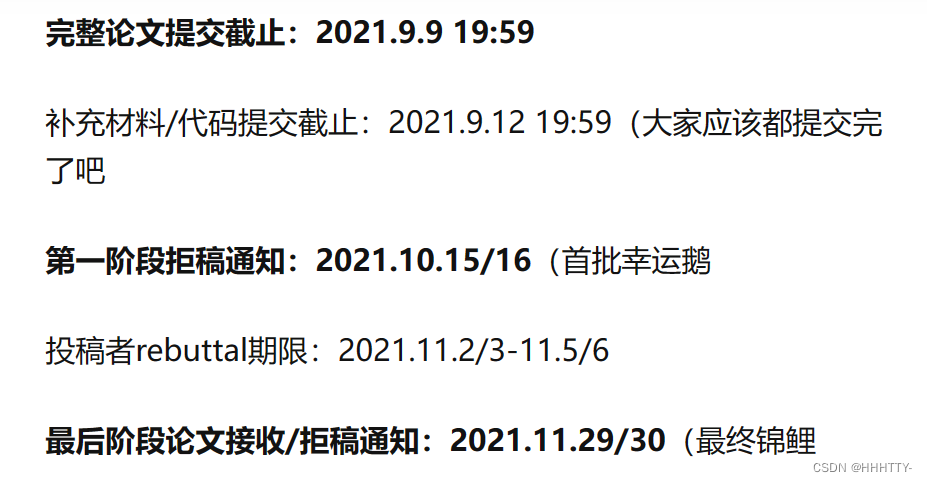
Questions and Suggestions Questions and Suggestions
-
Please send queries about conference registration to [email protected].
-
Please direct inquiries about the submission process and the technical program to [email protected] and [email protected] respectively.
-
Other general inquiries to the AAAI-24 General and Program Co-chairs can be directed to [email protected].
Please send inquiries regarding conference registration to [email protected].
Please send inquiries regarding the submission process and technical procedures to [email protected] and [email protected] respectively.
Other general inquiries to the AAAI-24 General Chair and Program Co-Chairs can be sent to [email protected].
Supplementary Material
Submissions should not contain pointers to supplementary material on the web, as this may violate both blind review and the policy that submissions cannot be changed after they are made available to reviewers. However, authors have the option of submitting supplementary material in support of their submissions. Authors must be very careful not to violate the double blind review requirements in any supplementary material to prevent their paper from being summarily rejected. All such material is due no later than August 18 (regular papers), and September 25 (NeurIPS-23 fast track papers).
Submissions should not contain pointers to supplementary material on the web, as this may violate the policy of double scrutiny and that submissions cannot be changed after they have been submitted to the reviewers.
- However, authors may choose to submit supplementary material in support of their submission.
Authors must be very careful not to violate the requirement of double-blind review in any supplementary material to prevent their paper from being summarily rejected.
The deadlines for all these materials are August 18 (regular papers) and September 25 (NeurIPS-23 fast-track papers).
Authors can include one or more of the following:
a technical appendix (PDF) containing additional details in support of the arguments advanced by the main paper (e.g., proofs, experimental results, descriptions of datasets);
a multimedia appendix (ZIP) including images, audio files, video demonstrations, etc., in support of the paper;
code & data (ZIP) to aid the reviewers in assessing the reproducibility of the paper’s claims.
During review, the purpose of supplementary material is to assist reviewers. Authors are encouraged to share the supplementary material upon paper acceptance.
Authors may include one or more of the following:
a. A technical appendix (PDF) containing additional details supporting the main paper's argument (e.g., proofs, experimental results, dataset descriptions);
b. A multimedia appendix (ZIP) including figures , audio files, video presentations, etc., to support the paper;
c. code and data (ZIP) , to help reviewers assess the reproducibility of the paper's claims.
The purpose of supplementary material is to assist reviewers during review. Authors are encouraged to share supplementary material after a paper has been accepted.
Technical Appendix
The length of main submissions is strictly limited, as already described. Authors may optionally submit a technical appendix (PDF) containing additional supporting information such as proofs of theorems that are stated in the main paper; additional information needed to reproduce experiments; further experimental results; figures and examples to illustrate technical claims; etc. The main submission may reference the supplementary material, but should be self contained. Reviewers will be instructed to make their acceptance evaluations based on the main submission, and will not be obliged to consult the supplementary material. If proofs or other supplementary matter are an important part of the contribution, their essential elements should be included in the main paper.
As mentioned earlier, the length of the main submission is strictly limited.
- Authors may choose to submit a technical appendix (PDF) containing additional information in support of the main thesis,
- such as proofs of theorems stated in the main thesis;
- Additional information needed to reproduce the experiment; more experimental results;
- Graphics and examples depicting technical claims, etc.
- Supplementary material may be referenced in the main submission, but should stand on its own.
Reviewers will be instructed to accept assessments based on the main submission and will not be obliged to consult supplementary material.- If proofs or other supplementary content are an important part of the contribution, their key elements should be included in the main paper.
Multimedia Appendix
Some authors may also wish to provide additional material, such as images, videos, audios or other multimedia to supplement their paper. All such files should be combined into a single .zip file and uploaded to the CMT server. As always, such submissions should be properly anonymized; authors are urged to take particular care to ensure that any submitted video avoids images of the authors, identifiable voices, university or lab logos, recognizable campus scenes, etc.
Some authors may also wish to provide additional material such as pictures, video, audio or other multimedia to supplement their paper.
- All these files should be combined into one .zip file and uploaded to the CMT server.
- Again, such submissions should be appropriately anonymized; authors should take special care to ensure that submitted videos avoid images of the author, recognizable voices, university or laboratory logos, recognizable campus scenes, etc.
Code & Data Appendix
Authors are encouraged to provide their software and all data needed to reproduce results in the paper as a third form of supplementary material. All files must be combined into a .zip file and uploaded to the CMT server. Reviewers may use this material to verify the claims made in the main paper and to assess the reproducibility of the work. If a dataset’s size exceeds the available max limit set by CMT, then authors are encouraged to upload a representative subset of their data.
Authors are encouraged to provide their software and all data needed to reproduce the paper's results as a third form of supplementary material.
- All files must be combined into one .zip file and uploaded to the CMT server. Reviewers may use these materials to verify claims made in the main paper and to assess the reproducibility of the work.
- Authors are encouraged to upload a representative subset of their data if the size of the dataset exceeds the available maximum limit set by CMT.

